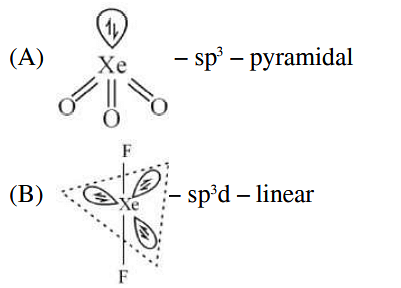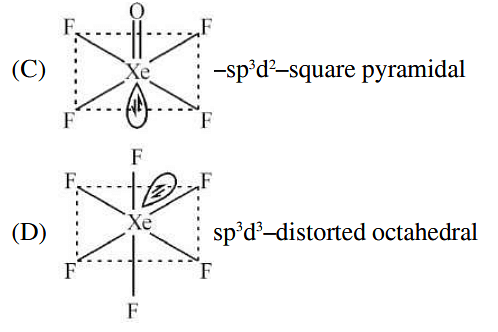Match List I with List II :
List-I (molecule) List-II (hybridization; shape) A XeO3 i sp3d ; linear B XeF2 ii sp3; pyramidal C XeOF4 iii sp3d3; distorted octahedral D XeF6 iv sp3d2 ;square pyramidal
Choose the correct answer from the options given below:
Match List I with List II :
| List-I (molecule) | List-II (hybridization; shape) | ||
|---|---|---|---|
| A | XeO3 | i | sp3d ; linear |
| B | XeF2 | ii | sp3; pyramidal |
| C | XeOF4 | iii | sp3d3; distorted octahedral |
| D | XeF6 | iv | sp3d2 ;square pyramidal |
Choose the correct answer from the options given below:
- A-II, B-I, C-IV, D-III
- A-II, B-IV, C-III, D-I
- A-IV, B-II, C-III, D-I
- A-IV, B-II, C-I, D-III
The Correct Option is A
Solution and Explanation


Top Questions on Chemical bonding and molecular structure
What is the empirical formula of a compound containing 40% sulfur and 60% oxygen by mass?
- MHT CET - 2025
- Chemistry
- Chemical bonding and molecular structure
Match the LIST-I with LIST-II.

Choose the correct answer from the options given below :- JEE Main - 2025
- Chemistry
- Chemical bonding and molecular structure
Which of the following molecules(s) show/s paramagnetic behavior?
$\mathrm{O}_{2}$
$\mathrm{N}_{2}$
$\mathrm{F}_{2}$
$\mathrm{S}_{2}$- JEE Main - 2025
- Chemistry
- Chemical bonding and molecular structure
- A group 15 element forms \( d\pi - d\pi \) bond with transition metals. It also forms a hydride, which is the strongest base among the hydrides of other group members that form \( d\pi - d\pi \) bonds. The atomic number of the element is ________________________.
- JEE Main - 2025
- Chemistry
- Chemical bonding and molecular structure
Given below are two statements:
Statement I : The N-N single bond is weaker and longer than that of P-P single bond
Statement II : Compounds of group 15 elements in +3 oxidation states readily undergo disproportionation reactions.
In the light of above statements, choose the correct answer from the options given below- JEE Main - 2025
- Chemistry
- Chemical bonding and molecular structure
Questions Asked in JEE Main exam
- The number of ways, 5 boys and 4 girls can sit in a row so that either all the boys sit together or no two boys sit together is:
- JEE Main - 2025
- Permutation and Combination
- Given a thin convex lens (refractive index \( \mu_2 \)), kept in a liquid (refractive index \( \mu_1, \mu_1<\mu_2 \)) having radii of curvature \( |R_1| \) and \( |R_2| \). Its second surface is silver polished. Where should an object be placed on the optic axis so that a real and inverted image is formed at the same place?
- JEE Main - 2025
- Optics and Refraction
- To obtain the given truth table, the following logic gate should be placed at G

- JEE Main - 2025
- Logic gates

For the circuit shown above, the equivalent gate is:
- JEE Main - 2025
- Logic gates
Let \( f : \mathbb{R} \to \mathbb{R} \) be a twice differentiable function such that \[ (\sin x \cos y)(f(2x + 2y) - f(2x - 2y)) = (\cos x \sin y)(f(2x + 2y) + f(2x - 2y)), \] for all \( x, y \in \mathbb{R}. \)
If \( f'(0) = \frac{1}{2} \), then the value of \( 24f''\left( \frac{5\pi}{3} \right) \) is:
- JEE Main - 2025
- Differential Calculus
Concepts Used:
Chemical Bonding and Molecular Structure
Such a group of atoms is called a molecule. Obviously, there must be some force that holds these constituent atoms together in the molecules. The attractive force which holds various constituents (atoms, ions, etc.) together in different chemical species is called a chemical bond.
Types of Chemical Bonds:
There are 4 types of chemical bonds which are formed by atoms or molecules to yield compounds.
- Ionic Bonds - Ionic bonding is a type of chemical bonding which involves a transfer of electrons from one atom or molecule to another.
- Covalent Bonds - Compounds that contain carbon commonly exhibit this type of chemical bonding.
- Hydrogen Bonds - It is a type of polar covalent bonding between oxygen and hydrogen wherein the hydrogen develops a partial positive charge
- Polar Bonds - In Polar Covalent chemical bonding, electrons are shared unequally since the more electronegative atom pulls the electron pair closer to itself and away from the less electronegative atom.
Factors Affecting Bond Enthalpy in Chemical Bonding:
- Size of the Atom
- Multiplicity of Bonds
- Number of Lone Pair of Electrons Present
- Bond Angle